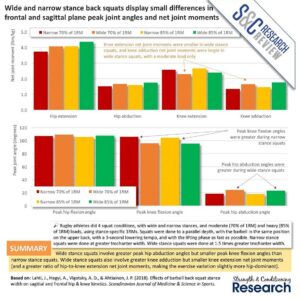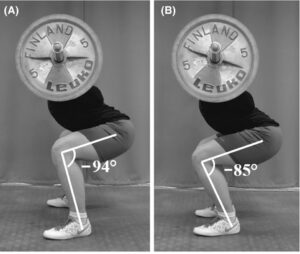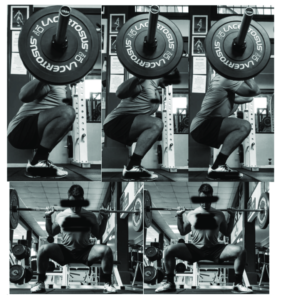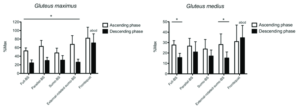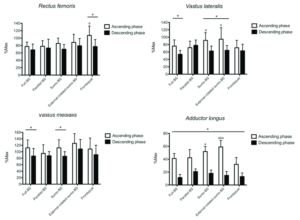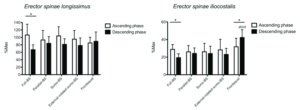2 LEG SQUATS – WIDTH – RESEARCH
Click on Image to Enlarge
MOMENT ARM STUDIES
HIP EXTENSORS & AB-DUCTORS, KNEE EXTENSORS & AD-DUCTORS
– Back Squats Wide & Narrow with 70%1RM & 85%1RM
Effects of barbell back squat stance width on sagittal and frontal hip & knee kinetics – 2019 – Lahti
– PDF File .
Procedure
– 14 adult amateur rugby athletes
– Width manipulation is thought to influence sagittal plane stimuli to the hip and knee extensors, the primary extensor musculature in the squat
– However, how width manipulation affects frontal plane stimuli is less understood
– Knowledge of hip and knee net joint moments (NJM) could improve exercise selection when aiming to improve sport‐specific performance and prevent injuries
1. WIDE: 1.5x greater trochanter width
2. NARROW: 1x greater trochanter width
– barbell back squats to femur parallel depth, using relative loads of 70 and 85% 1RM
NJM – Net Joint Moments
Hip Extension: 85%1RM Wide=4.3 . 70%1RM Wide=4.0 . 85%1RM Narrow=4.0 . 70%1RM Narrow=3.7
+ Hip Ad-duction: 85%1RM Wide=1.8 . 70%1RM Wide=1.7 . 85%1RM Narrow=1.4 . 70%1RM Narrow=1.3
Knee Extension: 85%1RM Narrow=2.6 . 70%1RM Narrow=2.5 . 85%1RM Wide=2.4 . 70%1RM Wide=2.3
Hip Ab-duction: 85%1RM Wide=1.8 . 70%1RM Wide=1.7 . 85%1RM Narrow=1.6 . 70%1RM Narrow=1.4
Peak Joint Angle in Degrees
Peak Hip Flexion Angle: 85%1RM Wide=110º . 70%1RM Wide=110º . 85%1RM Narrow=105º . 70%1RM Narrow=105º
Peak Knee Flexion Angle: 70%1RM Narrow=110º . 85%1RM Narrow=105º . 85%1RM Wide=95º . 70%1RM Wide=95º
Peak Ab-duction Angle: 85%1RM Wide=23º . 70%1RM Wide=23º . 85%1RM Narrow=19º . 70%1RM Narrow=19º
EMG STUDIES
GLUTEUS MAXIMUS & MEDIUS, QUADS, ADDUCTOR LONGUS, ERECTOR SPINAE
– Full & Parallel Back Squat, Full Front Squat, Wide Squat, Wide Squat with toes out
Gluteal, Quads, Adductor Longus, Lower Back in Different Squat Variations Performed by Competitive Bodybuilders – 2021 – Coratella
Procedure
– 10 male competitive bodybuilders perform back-squat at 80% 1-RM:
(1) full back squat (F-BS)
(2) parallel back squat (P-BS)
(3) wide stance – sumo (WS-BS)
(4) wide stance sumo feet external rotated (WS-ER-BS)
(5) parallel front-squat (P-FS)
Results
Gluteus Maximus:Parallel Front 80 . WS-ER-BS 65 . Parallel Back 60 . Full Back 55 . WS-BS 50
Gluteus Medius: Parallel Front 32 . WS-ER-BS 28 . Full Back 28 . Parallel Back 27 . WS-BS 26
Rectus Femoris: Parallel Front 105 . WS-ER-BS 85 . WS-BS 85 . Parallel Back 80 . Full Back 80
Vastus Lateralis: WS-ER-BS 95 . WS-BS 90 . Full Back 75 . Parallel Back 70 . Parallel Front 70
Vastus Medialis: WS-ER-BS 125 . WS-BS 110 . Full Back 110 . Parallel Front 110 . Parallel Back 90
+ Adductor Longus: WS-ER-BS 60 . WS-BS 50 . Parallel Back 40 . Full Back 40 .Parallel Front 30
+ Erector Spinalis Longissimus: Full Back 105 . WS-BS 100 . WS-ER-BS 95 . Parallel Back 90 . Parallel Front 85
+ Erector Spinalis Iliocostalis: Parallel Front 32. Full Back 30 . WS-ER-BS 30 . Parallel Back 28 .WS-BS 25
GLUTEUS MAXIMUS & MEDIUS, RECTUS FEMORIS, V. LATERALIS, V. MEDIALIS
AD-DUCTOR MAJOR, BICEPS FEMORIS, SEMTENDINOSUS
– Back Squats with 3 different stance width and 3 different Loads
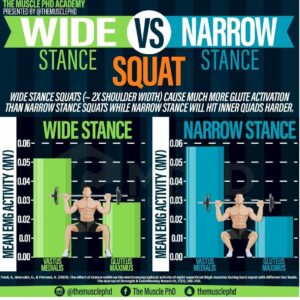
 The Effect of Stance Width on Activity of 8 Thigh Muscles During Back Squat With Different Bar Loads – 2009 – Paoli
The Effect of Stance Width on Activity of 8 Thigh Muscles During Back Squat With Different Bar Loads – 2009 – Paoli
Procedure
– 6 experienced lifters performed 3 sets of 10 reps
– 3 widths (100, 150, and 200% of great trochanter distance [GTd])
– 3 resistances: no load, 30% of 1-repetition maximum (1RM), and 70% 1RM.
Results @70% 1RM
Gluteus Maximus: wide 30% . mid 25% . narrow 20%
Gluteus Medius: wide 24% . mid 20% . narrow 18%
Rectus Femoris: narrow 58% . wide 51% . mid 50%
Vastus Lateralis: wide 66% . mid 60% . narrow 60%
Vastus Medialis: mid 57% . narrow 57% . wide 53%
+ Ad-ductor Longus (Major): wide 30% . mid 25% . narrow 20%
+ Biceps Femoris: wide 27% . mid 26% . narrow 25%
+ Semitendinosus: wide 25% . mid 24% . narrow 23%
